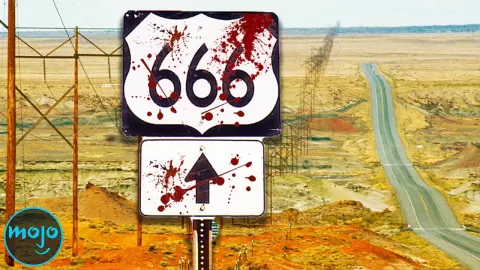America's Top 10 Most Dangerous Roads

#10: Dalton Highway
Alaska
Stretching from Livengood to Prudhoe Bay, the Dalton Highway is primarily an industrial road servicing the oil fields of Alaska's North Slope. It's renowned for its difficult terrain, with steep grades, frozen river crossings, and minimal services, demanding well-prepared and equipped drivers to navigate its icy expanses safely. Fuel stops are infrequent, and winter temperatures can plummet to extreme lows, posing a threat to both vehicles and individuals. Despite the hardships, the Dalton offers a unique glimpse into Alaska's vast wilderness and is home to diverse wildlife, including grizzly bears and caribou.
#9: U.S. Route 550
Colorado
Running through the San Juan Mountains, the Million Dollar Highway gains its name from the incredible views of the surrounding peaks. However, its hairpin turns and lack of guardrails make it notorious for accidents, particularly around the Red Mountain Pass, where the road reaches an elevation of over 11,000 feet. Drivers need to take caution during winter months when it is susceptible to avalanches, adding an extra layer of danger to an already tricky drive. But it’s not all about danger. 550 provides access to historic mining towns like Silverton and Ouray, showcasing the rich heritage of Colorado's mining industry.
#8: Pacific Coast Highway
California
Also known as State Route 1, this long and winding road is famous for its picturesque coastal views, but its susceptibility to landslides and rockfalls poses ongoing issues. The iconic Bixby Creek Bridge and winding sections along Big Sur contribute to its allure, but drivers must contend with the risk of closures due to natural events. It’s important to plan for potential delays, especially after heavy rainfall, which can trigger mudslides. Risks aside, the Pacific Coast Highway is a dream drive for those seeking breathtaking ocean vistas and a taste of California's rugged beauty.
#7: U.S. Route 431
Alabama
Known locally as the "Highway to Hell," Alabama State Route 431 encounters treacherous terrain with the difficult climb up Sand Mountain. Heavy truck traffic and limited passing opportunities amplify the risks, earning it a reputation as one of the state's most accident-prone stretches. The nickname stems from the difficulty of navigating its steep ascents and descents, not from any supernatural elements. While improvements have been made to enhance safety, travelers should remain vigilant, especially on the winding sections near Guntersville. But its importance can’t be overlooked — it is a crucial artery for transportation in the region.
#6: Route 666
New Mexico
Renamed as Route 491, this road was once infamous in its naming and is associated with folklore and superstitions. While the renumbering aimed to dispel its dark reputation, its isolation, harsh weather conditions, and a history of accidents still contribute to its mystique. Some older maps might still refer to it as Route 666, reflecting the enduring cultural fascination with the supposedly Satanic number. Despite its ominous associations, 491 provides access to the Navajo Nation and offers a unique perspective on the diverse landscapes of New Mexico, blending desert expanses with high mesas.
#5: Nevada State Route 375
Nevada
Running adjacent to the secretive Area 51, Nevada State Route 375 gained fame as the Extraterrestrial Highway. Aside from its proximity to the mysterious military base, its main issues stem from its remoteness, long stretches without services, and the potential for extreme desert temperatures. Anyone interested in extraterrestrial lore might want to explore nearby attractions like the Little A'Le'Inn in Rachel, where they can learn about UFO sightings and Area 51 conspiracy theories. While it attracts curious visitors, this dangerous highway remains an essential route for transportation through the Nevada desert.
#4: U.S. Route 2
Montana
Known as the Hi-Line, this drive traverses the northern part of the state, offering expansive views of prairies and farmland. However, its lengthy straightaways contribute to monotony, and harsh winter conditions, including blizzards and icy conditions create hazards for drivers, requiring vigilance and preparation. Of note is that the Hi-Line passes through historic towns like Havre and Glasgow, providing glimpses into Montana's agricultural and transportation heritage. It offers a unique perspective on the vast landscapes of Big Sky Country, with opportunities to explore local culture and history.
#3: U.S. Route 17
Florida
This highway in Florida has earned a reputation as one of the state's deadliest due to a relatively elevated number of accidents. Factors such as speedy traffic, frequent congestion in urban areas, and variable weather conditions contribute to its risky nature. Caution is required, especially in densely populated regions like Jacksonville and Orlando, where it passes through heavily trafficked areas. Route 17 still serves as a vital transportation corridor, connecting Florida's east and west coasts and facilitating commerce and travel throughout the state.
#2: Beartooth Highway
Wyoming & Montana
Connecting Wyoming and Montana, Beartooth offers stunning views of the Absaroka and Beartooth Mountains. However, its elevations, sharp switchbacks, and exposure to rapidly changing weather patterns make it a potentially hazardous drive, especially during the winter months. Anyone driving on this wild highway should be on guard for altitude sickness, and check for road closures before embarking on the journey. Yet its breathtaking vistas and access to outdoor recreation areas like Yellowstone National Park make it popular and rewarding for adventurous drivers.
#1: U.S. Route 6
Nevada
Designated as the Loneliest Road in America, US Route 6 in Nevada crosses vast, sparsely populated landscapes. With long stretches between services, extreme temperatures, and minimal civilization, it challenges travelers with its remote and desolate character, demanding self-sufficiency and careful planning. Travelers need to carry ample supplies, including water and fuel, and be prepared for limited cell phone reception. The Loneliest Road does offer a unique opportunity for solitude and reflection, allowing travelers to experience the stark beauty of the desert while navigating its isolated expanses.
What do you think is the most difficult or dangerous drive in the U.S.? Let us know in the comments below!


